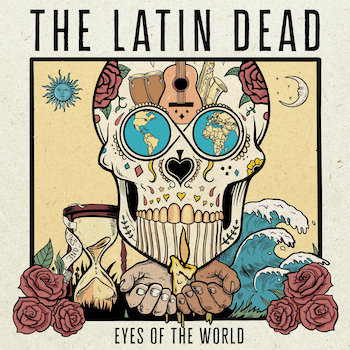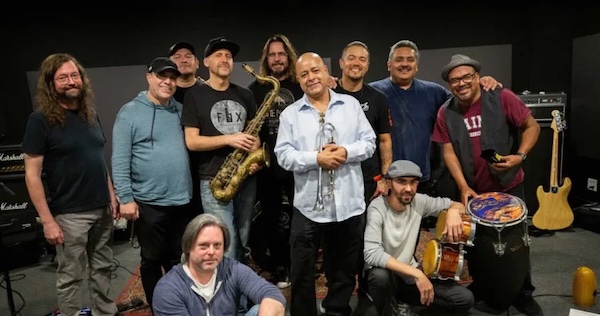Rock Album Review: The Latin Dead’s “Eyes of the World” — Revolutionary Pop/Rock/Latin Fusion
By Brooks Geiken
Until this album, I had no idea that the Grateful Dead and salsa could blend together with such force and fun.
 Imagine growing up loving the Grateful Dead’s music and then learning to play congas and bongo. Brenden Tacón did just that and then envisioned a space where these two seemingly disparate musical elements could coexist and flourish. On Eyes of the World, The Latin Dead, led by Tacón and musical director Oscar Hernández, have created a fusion of two genres with astoundingly good results.
Imagine growing up loving the Grateful Dead’s music and then learning to play congas and bongo. Brenden Tacón did just that and then envisioned a space where these two seemingly disparate musical elements could coexist and flourish. On Eyes of the World, The Latin Dead, led by Tacón and musical director Oscar Hernández, have created a fusion of two genres with astoundingly good results.
The inspiration for this project goes back decades. Tacón’s father, Derek, took him to see the Dead perform in 1994 and that led to his fascination with the music and the Grateful Dead scene. A few years later in New York Tacón began to play congas and bongo, but the music of the Dead still reverberated in his head. In 2010 Tacón envisioned a dream project: to put the Dead’s music to a Latin beat. The lockdown in 2020 gave Tacón the time to plan and pull together the funds to make the album. But he needed some heavyweight musical help: Tacón approached Oscar Hernández, renowned bandleader and pianist. Hernández admitted to me he was not a fan of the Dead’s music, but Tacón would not be denied and kept pressing him. Hernández finally decided he would expand his horizons and accept the challenge of being the musical director of what would eventually become The Latin Dead. With Hernández on board, Tacón spent time working him, selecting the tunes and choosing the band members. With arrangements by Hernández, Marty Sheller, Chris Burke, Angel Fernández, and Francisco Torres in hand they headed to the rehearsal hall for three days of work. In the studio they ended up making music history with this revolutionary pop/rock/latin fusion.
The album’s success can partly be attributed to Hernández and Tacón assembling a treasure trove of excellent studio musicians. The electric guitar parts are played with winning heart by John Kadlecik, a jam band scene veteran whose style that combines Trey Anastasio and Jerry Garcia. The horns — Francisco Torres on trombone, Katisse Buckingham on tenor sax and flute and Peter Nater on trumpet — slide in and out of the tunes with nuanced precision. Charlie Chávez, Tacón, and Andy Sanesi hold down the rhythm on congas, bongos, percussion, and drums.
The Latin Dead cover a wide range of the Dead’s output, from “One More Saturday Night” to “Shakedown Street.” It is refreshing that the choices include Dead music that has not been recorded to death (pun intended). The songs cover a considerable emotional range, and Hernández draws on his vast knowledge of Cuban music to great effect. For example, we hear echoes of Bugalú on the cover of “The Golden Road (To Unlimited Devotion)” from the Dead’s first record. The use of the bolero rhythm on “Looks Like Rain” complements the love song, adding a welcome accent of mellowness.
The contributions of the musicians on Eyes of the World are varied and impressive. The horn section really shines on the opening number “Mississippi Half-Step Uptown Toodeloo.” The horns set up an unexpectedly shifting vibe that suggests this will be an exciting excursion into previously unexplored musical territory. “Franklin’s Tower” has the distinction of pulling off a two-part harmony in the chorus: Andy Vargas and John Kadlecik’s voices blend nicely. Katisse Buckingham’s flute solo on “Looks Like Rain” adds a delightfully soft touch. With “Crazy Fingers” Hernández steps up and lays down a powerful solo on piano, as does Kadlecik on guitar. The natural warmth of Francisco Torres’s trombone solo steals the spotlight on “Eyes of the World.”
Andy Vargas’s vocals deserve special mention. He brings the necessary fierce fervor to “Shakedown Street,” delivers the geriatric goods on “A Touch Of Grey,” and rocks hard on “Eyes of the World.” He manages to channel the Dead’s spirit without resorting to obvious (and needless) imitation.
Let’s face it: electric guitar can be pretty boring at times, especially when the guitarist becomes obsessed with noodling and repeating phrases. Kadlecik doesn’t fall into that self-indulgent trap. He brings a disciplined style and brevity to his solos on the album. He has carefully constructed his work here — it is lean and mean, his knowledge of the Dead giving him the freedom to create some cool improvisations.

The Latin Dead. Photo: Christopher Markisz
When it comes to the Dead and Latin music, I share Tacón’s trajectory. I grew up in the San Francisco Bay Area and listened to the Dead’s music for many years. In the late ’70s my musical tastes began to expand and I looked to New York and the salsa scene for inspiration. Until this album, I had no idea that the Dead and salsa could blend together with such force and fun. The Latin Dead supply a swinging underpinning to the lyrics and harmonies of the Dead’s music. They have spent considerable time thinking and playing this music, which they love and respect. The result is that they have come up with a synthesis that takes the music to a different and wonderful place, and by doing so will no doubt introduce it to new generations. The older Deadheads will get off on the lyrics and the familiar tunes — the younger generation will dig the danceable beat.
The Latin Dead will be appearing at The Brooklyn Bowl, Brooklyn, NY, on July 26, The Brooklyn Bowl, Philadelphia, PA, on the 27th, The Met in Pawtucket, RI, on the 29th and The Park City Music Hall in Bridgeport, CT, on the 30th.
Brooks Geiken is a retired Spanish teacher with a lifelong interest in music, specifically Afro-Cuban, Brazilian, and Black American music. His wife thinks he should write a book titled, The White Dude’s Guide to Afro-Cuban and Jazz Music. Brooks lives in the San Francisco Bay Area.
Tagged: Brenden Tacón, Eyes of the World, Oscar Hernández, the Grateful Dead
